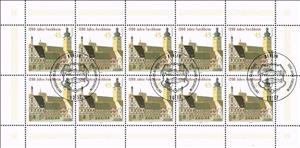Mini Sheet: City Hall (Germany, Federal Republic 2005)
City Hall (Germany, Federal Republic 2005)
03 January (Germany, Federal Republic ) within release 1200 years Forchheim goes into circulation Mini Sheet City Hall face value 10*45 Euro cent
| Mini Sheet City Hall in catalogues | |
|---|---|
| Michel: | Mi: DE 2438KB |
Mini Sheet is square format.
Also in the issue 1200 years Forchheim:
- Stamp - Celtic prince of Glauberg (stone statue, 5th century BC) face value 144;
- Stamp - Adoration of the Magi; Cologne panel painting (about 1350) face value 55;
- Stamp - City hall face value 45;
- Mini Sheet - City Hall face value 10*45;
Mini Sheet City Hall it reflects the thematic directions:
An anniversary is the date on which an event took place or an institution was founded in a previous year, and may also refer to the commemoration or celebration of that event. For example, the first event is the initial occurrence or, if planned, the inaugural of the event. One year later would be the first anniversary of that event. The word was first used for Catholic feasts to commemorate saints. Most countries celebrate national anniversaries, typically called national days. These could be the date of independence of the nation or the adoption of a new constitution or form of government. The important dates in a sitting monarch's reign may also be commemorated, an event often referred to as a "Jubilee".
A building or edifice is a structure with a roof and walls standing more or less permanently in one place, such as a house or factory. Buildings come in a variety of sizes, shapes and functions, and have been adapted throughout history for a wide number of factors, from building materials available, to weather conditions, to land prices, ground conditions, specific uses and aesthetic reasons. Buildings serve several needs of society – primarily as shelter from weather, security, living space, privacy, to store belongings, and to comfortably live and work. A building as a shelter represents a physical division of the human habitat (a place of comfort and safety) and the outside (a place that at times may be harsh and harmful).
The City Halls are part of a market complex designed by John Carrick in 1882, but the grand hall itself was designed by George Murray and opened in 1841. It was the first hall suitable for large gatherings and concerts to be built in the City and played host to the likes of Benjamin Disraeli, Charles Dickens, Hungarian patriot Lajos Kossuth and William Ewart Gladstone. From its early days it hosted a wide variety of popular and classical concerts including those by touring groups such as Louis-Antoine Jullien's celebrated London-based orchestra and Charles Halle's orchestra from Manchester. Glasgow's first regular orchestral subscription concert series, played by an orchestra managed by the Glasgow Choral Union, was given in the grand hall from 1874 until the opening of the much larger St Andrew's Hall in 1877. Arthur Sullivan was its conductor for two seasons from 1875 to 1877. The Old Fruitmarket directly adjoins the grand hall and was a functioning market until the 1970s after which it was in occasional use for jazz and folk music events. The adjoining buildings were home to bustling produce markets such as the fresh fruit and flower market and the cheese market.



